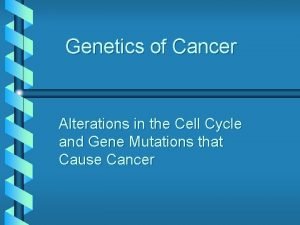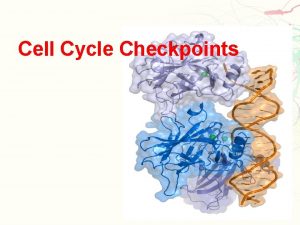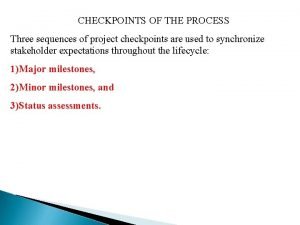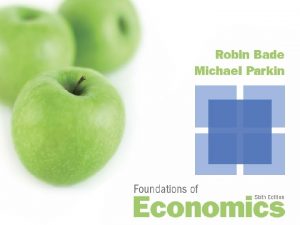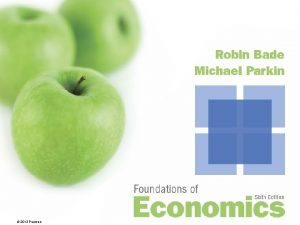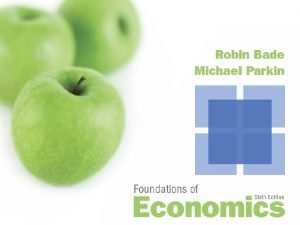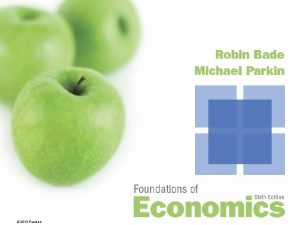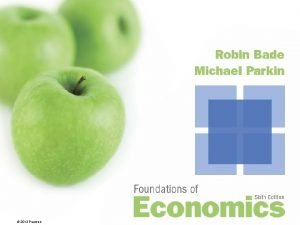Chapter 9 Checkpoints of the process 1 Introduction





















- Slides: 21

Chapter – 9 Checkpoints of the process 1

Introduction The purpose of checkpoint is to achieve The following § Synchronize stakeholder expectations & achieve concurrence on three evolving Perspective : Requirements, design & Plan § Synchronize related artifacts into consistent & balance state § Identify the important risks, issues & out-of-tolerance conditions § Perform a global assessment for the whole life cycle 2

Introduction Three sequences of project checkpoints are used to synchronize stakeholders expectations throughout the life cycle § Major milestones § Minor milestones § Status assessments 3

Major milestones § These system wide events are held at the end of each development phase § They provide visibility of system wide issues, Synchronize the management & engineering perspectives & verify that the aims of the phase have been achieved Note: The most important major milestone is usually the event that transitions the project from elaboration phase into construction phase 4

Minor milestones § These iteration focused events are conducted to review the content of iteration in detail & to authorize continued work § The formats & content of minor milestones are highly dependent on the project & the organizational culture. Status Assessment § The periodic events provides management with frequent & regular insight into the progress being made § Periodic status assessments are crucial for focusing continuous attention on the evolving health of the project & its dynamic priorities 5

Typical sequence of life cycle checkpoints Life cycle objective milestone Life Cycle Architecture milestone initial operational capability milestone Product release milestone Major Milestones Minor Milestones Status Assessment 6

The general status of plan, requirement & product across major milestones Milesstone Life Cycle objectives Milestone Plans Definition of the stakeholder Responsibilities Low-fidelity life cycle plan High-fidelity elaboration Phase plan Life Cycle architecture milestone Requirements Product Baseline Vision, including Growth vectors, Quality Attributes & priorities Demonstration of at least One feasible architecture User case model Initial design model High-fidelity construction Phase plan Stable vision & use case Model Low-fidelity transition plan Evaluation criteria for Construction release, Initial operational capability Make buy/reuse trade-offs Stable design set Make buy/reuse decisions Critical component prototyoes Draft user manual Initial operational capability milestone High-fidelity transition plan Acceptance criteria for Product release Release user manual Product release milestones Next generation product plan Final user manual Stable implementation set Critical features & core Capabilities Objective insight into Product qulaties Stable deployment set 7 Full features Complaint quality

Major milestones(1 of 6 ) The four major milestones occur at the transition points between lifecycle phases which are used to achieve concurrence among all stakeholders on the current state of product. Different stakeholders have different concerns § Customers schedule & budget estimates, feasibility , risk assessment, requirement understanding, progress, product line compatibility § Users Consistency with requirements & usage scenarios, potential for accommodating growth, quality attributes § Architects & System engineers Product line compatibility, requirements changes, trade-off analysis, completeness & consistency, balance among risks, quality & usability. § Developers Sufficiency of requirements detail & usage scenario descriptions, frameworks for component selection or development, resolution of development risk, product line 8 compatibility, sufficiency of the development environment

Major milestones ( 2 of 6 ) § Maintainers Sufficiency of product & documentation artifacts, understandability, interoperability with existing systems, sufficiency of maintenance environment. § Others possibly many other perspectives by stakeholders such as regulator agencies, independent verification & validation contractors, venture capital investors, subcontractors, associate contractors, & sales & marketing teams 9

Major milestones ( 3 of 6 ) The four major milestones are § Life cycle objectives milestones § Life cycle architecture milestones § Initial operational capability milestone § Product release milestone 10

Major milestones ( 4 of 6 ) Life Cycle objectives milestone The life cycle objective milestone occur at the end of inception phase. This will result in authorization from all stakeholders to proceed with elaboration phase § The goal is to present all stakeholders a Recommendation on how to proceed with development including a plan, estimated cost & schedule, expected benefits & cost savings § The vision & critical issues related to requirements & operational concepts are addressed § A draft architecture & a prototype architecture demonstration provide evidence of the completeness of the vision & the development plan 11

Major milestones ( 5 of 6 ) Life cycle Architecture milestone The Life cycle architecture milestone occurs at the end of elaboration phase § § The primary goal is to demonstrate an executable architecture to all stakeholders. A more detail plan for construction phase is presented for approval Critical issues relative to requirement & operational concept are addressed The software development project ready for this transition exhibits the following characteristics § § The critical use case have been defined A stable architecture is baselined The risk profile is well understood The development plan for the construction & transition phase is defined 12

Majormilestone (6 of 6 ) Initial operational capability milestone The Initial operational capability milestone occurs late in the construction phase. The goals are § To assess the readiness of the software to begin the transition into customer / user sites & to authorize the start of acceptance testing § Issues are addresses concerned to installation instructions, Software version description & user manuals & the ability of the development organization to support user sites. Product release milestone The product release milestone occurs at the end of the transition phase. The goal is to assess the completion of the software 7 its transition to the support organization § The results of acceptance testing are reviewed & all open issues are addressed which includes installation instructions, software version descriptions, user & operator manuals, software support manuals & installation of the development 13 environment at the support sites

Minor milestones ( 1 of 3 ) The number of iteration specific, informal milestones needed depends on the content & the length of the iteration For most iterations only two minor milestones are needed § Iteration readiness review § Iteration assessment review 14

Minor milestone ( 2 of 3 ) Iteration readiness review This informal milestone is conduct at the start of each iteration to review the detailed iteration plan & evaluation criteria that have been allocated to this iteration Iteration assessment review This informal milestone is conducted at the end of each iteration to assess the degree to which the iteration achieved its objectives & satisfied its evaluation criteria 15

Minor milestone ( 3 of 3 ) Typical Minor milestones in the life cycle of an iteration Management Requirement Design Implementation Assessment Deployment Iteration N-1 I Iteration N+1 Iteration N Initiation Iteration Readiness Review Iteration Design Walkthrough Iteration Assessment Review Iteration N Closeout 16

Periodic Status Assessments ( 1 of 5 ) Managing risks requires continuous attention to all the interacting activities of a software development effort. Periodic status assessment are § Management reviews conducted at regular intervals to address progress & quality indicators § Ensure continuous attention to project dynamics § Maintain open communications among all stakeholders 17

Periodic Status Assessment ( 2 of 5 ) Objective of periodic Status Assessment The main objective of status assessment is to ensure that the expectations of all stakeholders are synchronized & consistent. Periodic status assessment serve as project snapshots. it provide the following § A mechanism for openly addressing, communicating & resolving management issues, Technical issues & project risks. § Derived directly from on-going activities & evolving product configuration. § A mechanism for disseminating process, progress, quality, trends, practices & experiences information to & from all stakeholders in an open forum 18

Periodic Status Assessment ( 3 of 5 ) Recurring themes from unsuccessful projects include status assessments that are § High-overhead activities because the work associated with generating the status is separate from the everyday work. § Frequently canceled because of higher priority issues that § Recurring themes from successful projects include status assessments that are Low-overhead activities because the material already § Rarely canceled because they are considered too important. require resolution. exists as everyday management data. 19

Periodic Status Assessment ( 4 of 5 ) Default content of status assessment reviews Topic Content Personnel Staffing Vs actuals, Attritions, Additions Financial Trends Expenditure plan Vs Actuals for the previous, current & next major milestone Revenue forecasts Top 10 Risks Issues & criticality, resolution Plan Quantification of exposure Technical progress Configuration baseline schedule for major milestone Software management metrics & indicators Current change trends Test & quality assessment 20 Cont.

Periodic Status Assessment ( 5 of 5 ) Default content of status assessment reviews Topic Major milestone plans & results Content Plan, Schedule & risks for the next major milestone Pass/fail results for all acceptance criteria Total product scope Total size, growth & acceptance criteria perturbations 21
 5 kinetic chain checkpoints
5 kinetic chain checkpoints Checkpoints in the cell cycle
Checkpoints in the cell cycle Dialogue control in session layer
Dialogue control in session layer Static posture meaning
Static posture meaning Homochromatin
Homochromatin Heighten salience of goals and objectives
Heighten salience of goals and objectives Hát kết hợp bộ gõ cơ thể
Hát kết hợp bộ gõ cơ thể Ng-html
Ng-html Bổ thể
Bổ thể Tỉ lệ cơ thể trẻ em
Tỉ lệ cơ thể trẻ em Voi kéo gỗ như thế nào
Voi kéo gỗ như thế nào Thang điểm glasgow
Thang điểm glasgow Hát lên người ơi
Hát lên người ơi Môn thể thao bắt đầu bằng chữ đua
Môn thể thao bắt đầu bằng chữ đua Thế nào là hệ số cao nhất
Thế nào là hệ số cao nhất Các châu lục và đại dương trên thế giới
Các châu lục và đại dương trên thế giới Công thức tiính động năng
Công thức tiính động năng Trời xanh đây là của chúng ta thể thơ
Trời xanh đây là của chúng ta thể thơ Cách giải mật thư tọa độ
Cách giải mật thư tọa độ 101012 bằng
101012 bằng độ dài liên kết
độ dài liên kết Các châu lục và đại dương trên thế giới
Các châu lục và đại dương trên thế giới

